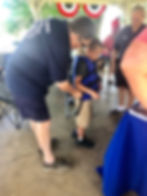Child Fatality Prevention: Life Jackets for All
- alexgilpin
- Jul 2, 2019
- 3 min read
Updated: Dec 15, 2020
Immediate Press Release for July 1, 2019
From the office of the Public Health Director
345 Courthouse Drive
Hayesville, NC 28904
828-389-8052
WATER SAFETY AND CHILD FATALITY PREVENTION EFFORTS

Every day, about ten people die from unintentional drowning. Of these, two are children aged 14 or younger. Drowning ranks fifth among the leading causes of unintentional injury death in the United States.1 More than 50% of drowning victims treated in emergency departments (EDs) require hospitalization or transfer for further care (compared with a hospitalization rate of about 6% for all unintentional injuries).1,2 These nonfatal drowning injuries can cause severe brain damage that may result in long-term disabilities such as memory problems, learning disabilities, and permanent loss of basic functioning (e.g., permanent vegetative state).(3,4)
The Clay County Health Department (CCHD) recently received a grant for child fatality prevention efforts, and an allocated amount of $3,000 was used to purchase lifejackets for Clay County infants, youth and teens. A partnership was developed with the local Coast Guard Auxiliary to assist with general safety education, proper jacket fitting assistance, and other technical supports. As of 29 June 2019, 98% of the jackets purchase were distributed to families within our community. The first point of distribution was at the Clay County Sheriff’s Office Summer Camp after campers were given intensive water and boater safety lessons. The second push focused on Clay County children that are in the foster care system along with county employee families. The final distribution was an all call for remaining community families that had not had the opportunity to pick theirs up from the health department. The push behind such aggressive distribution was a result of the statistics on holiday weekends and water safety incidences in our area, with CCHD wanting to assure as many jackets were available before the 4th of July lake and pool festivities. In a report from accessWDUN, over the three-day Memorial weekend in 2019 there were three drownings and 2 deaths on North Georgia lakes. (5)
There are 10 top tips for water safety recommended by the Centers for Disease Control and Prevention 6 ;
345 Courthouse Drive Hayesville, NC 28904 (828) 389-8052
DO learn to swim. If you like to have a good time doing water activities, being a strong swimmer is a must.
DO take a friend along. Even though you may be a good swimmer, you never know when you may need help. Having friends around is safer and just more fun!
DO know your limits. Watch out for the “too’s” — too tired, too cold, too far from safety, too much sun, too much hard activity.
DO swim in supervised (watched) areas only, and follow all signs and warnings.
DO wear a life jacket when boating, jet skiing, water skiing, rafting, or fishing.
DO stay alert to currents. They can change quickly! If you get caught in a strong current, don’t fight it. Swim parallel to the shore until you have passed through it. Near piers, jetties (lines of big rocks), small dams, and docks, the current gets unpredictable and could knock you around. If you find it hard to move around, head to shore. Learn to recognize and watch for dangerous waves and signs of rip currents — water that is a weird color, really choppy, foamy, or filled with pieces of stuff.
DO keep an eye on the weather. If you spot bad weather (dark clouds, lighting), pack up and take the fun inside.
DON’T mess around in the water. Pushing or dunking your friends can get easily out of hand.
DON’T dive into shallow water. If you don’t know how deep the water is, don’t dive.
DON’T float where you can’t swim. Keep checking to see if the water is too deep, or if you are too far away from the shore or the poolside.
1. Centers for Disease Control and Prevention, National Center for Injury Prevention and Control. Web-based Injury Statistics Query and Reporting System (WISQARS) [online]. [cited 2012 May 3]. Available from: URL: http://www.cdc.gov/injury/wisqars. 2. CDC. Wide-ranging online data for epidemiologic research (WONDER). Atlanta, GA: CDC, National Center for Health Statistics; 2016. Available at http://wonder.cdc.gov. 3. Cummings P, Quan L. Trends in Unintentional Drowning: The Role of Alcohol and Medical Care. JAMA, 1999; 281(23):2198-2202. 4. Spack L, Gedeit R, Splaingard M, Havens PL. Failure of aggressive therapy to alter outcomes in pediatric near-drowning. Pediatric Emergency Care 1997; 13(2):98-102. 5. https://accesswdun.com/article/2019/5/798729/dnr-traffic-up-on-state-patrolled-waterways-for-memorial-day-so-are-buis-other-problems 6. https://www.cdc.gov/bam/safety/h2o.html
